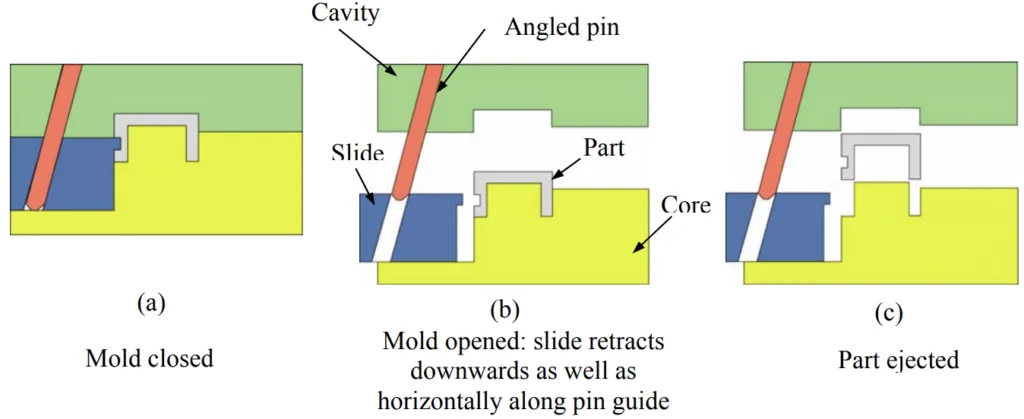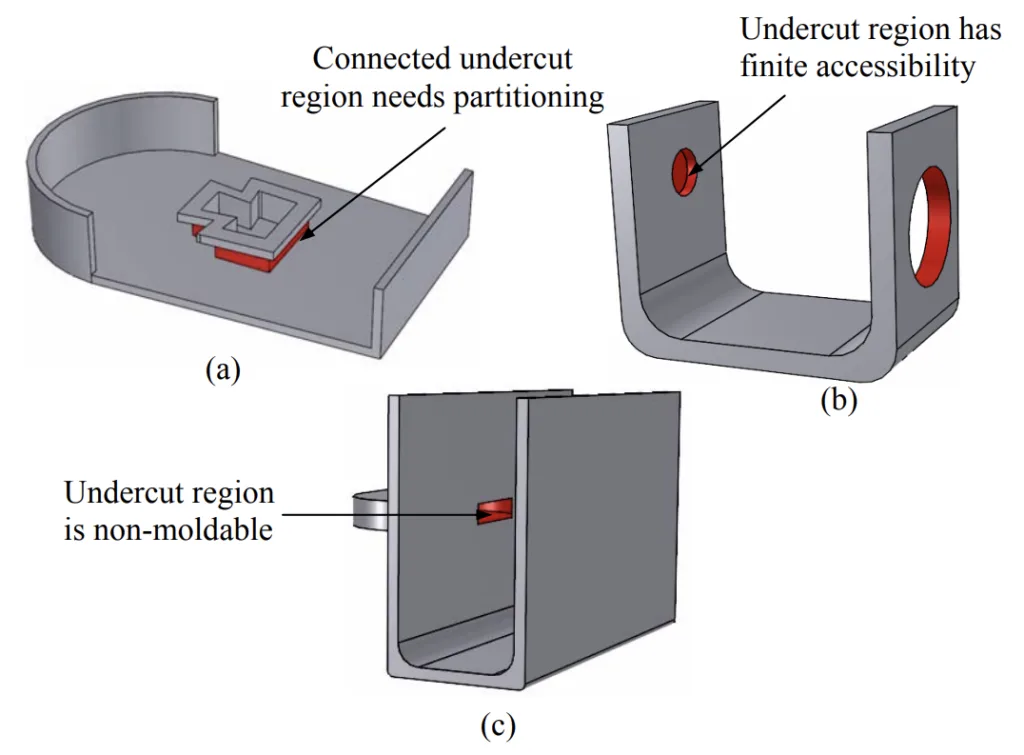この研究は、複雑な部品製造の重要な側面に対処し、金型設計を合理化し、生産コストを最適化するための道筋を提供します。
1. 概要:
- タイトル: Geometrical algorithms for automated design of side actions in injection moulding of complex parts(複雑な部品の射出成形におけるサイドアクション自動設計のための幾何アルゴリズム)
- 著者: アシシュ・ゴパル・バナジー (Ashis Gopal Banerjee) および サティエンドラ・K・グプタ (Satyandra K. Gupta)
- 出版年: 2007年
- 掲載ジャーナル/学会: Computer-Aided Design
- キーワード: 幾何アルゴリズム, 自動設計, サイドアクション, 射出成形, アンダーカット, コスト関数 (Geometric Algorithms, Automated Design, Side Actions, Injection Molding, Undercuts, Cost Function)

2. 研究背景:
- 研究トピックの社会的/学術的背景: 複雑な射出成形部品には、主要な金型開閉方向からアクセスできない アンダーカット と呼ばれる形状が頻繁に含まれます。 サイドアクション、つまり二次的な金型部品は、これらのアンダーカットを成形するために不可欠です。しかし、サイドアクションを手動で設計することは「困難な作業」であり、「かなりの専門知識」を必要とします。この手作業によるプロセスは、追加の製造、組み立て、および成形サイクル時間の長期化により、金型コストの増加に繋がります。したがって、サイドアクションの自動設計は、金型設計のリードタイムを短縮し、射出成形プロセス全体を最適化するために非常に重要です。
- 既存研究の限界: 既存のサイドアクション設計手法は、最適なソリューションを提供するには不十分な場合があります。複雑なアンダーカット領域が (1) サイドアクションを生成するために分割する必要がある場合、(2) アクセス性が限られている場合、または (3) 成形が不可能な場合、(つまり、実行可能なソリューションの網羅的なセットから最適なソリューションを生成できない場合)、「既存の方法は必ずしも満足のいくように機能しません」。多くの手法は「ヒューリスティックな方向」に依存しており、金型部品の干渉を検証するために「後処理操作(シミュレーションなど)」が必要になる場合があります。
- 研究の必要性: 本研究は、手動手法および既存の自動化アプローチの限界を克服するために、サイドアクションの自動設計の必要性に対処しています。自動設計は、「金型設計のリードタイムを大幅に短縮」し、「カスタマイズ可能な成形コスト関数」を最小限に抑えることでプロセスを最適化することを約束します。この研究は、射出成形技術を進歩させ、複雑な部品の効率的な製造を可能にするために不可欠です。
3. 研究目的と研究課題:
- 研究目的: 主な研究目的は、「カスタマイズ可能な射出成形コスト関数を最小限に抑えるためのサイドアクションの形状を生成するアルゴリズムを記述すること」です。この論文は、既存の手法が複雑なアンダーカット領域に対して不適切な場合に、「これらのタイプのケースに対処するための新しいアルゴリズムを提示する」ことを目指しています。
- 主な研究課題: 本研究は、以下の問いに答えることを目指しています。
- 幾何アルゴリズムは、アンダーカットのある複雑な射出成形部品のサイドアクションの設計をどのように自動化できるか?
- カスタマイズ可能な成形コスト関数は、サイドアクション設計を最適化するために、自動設計プロセスにどのように統合できるか?
- 分割が必要なアンダーカット領域や、アクセス性が制限されたアンダーカット領域など、複雑なアンダーカット領域をアルゴリズム的に効果的に処理するにはどうすればよいか?
- 研究仮説: 明確には述べられていませんが、根底にある仮説は、「本論文で提示された結果は、サイドアクションを設計するための完全自動化されたソフトウェアを開発するための基礎を提供するだろう」ということです。著者らは、幾何アルゴリズムを開発してサイドアクション設計を自動化し、複雑なアンダーカット形状に効果的に対処し、カスタマイズ可能な成形コスト関数を最小限に抑えることができると提案しています。
4. 研究方法
- 研究デザイン: 本研究では、計算幾何学に基づいたアプローチを採用し、サイドアクションの自動設計のための幾何アルゴリズムの開発と実装に焦点を当てています。
- データ収集方法: 研究では、入力として多面体部品と金型エンクロージャの幾何モデルを利用しています。開発されたアルゴリズムをテストおよび検証するために、計算実験が実施されます。
- 分析方法: アルゴリズムは、計算時間、探索空間内のノード数、分岐係数などの指標に基づいてパフォーマンスを評価する計算実験を通じて分析されます。「深さ優先分岐限定アルゴリズム」、「ミンコフスキー和」、「衝突検出」、「スイープベース衝突ポリゴン」などの手法がアルゴリズム内で使用されています。
- 研究対象と範囲: 本研究は、射出成形における「アンダーカットファセット」を持つ「多面体部品」のサイドアクションの設計に焦点を当てています。範囲は、「主要な金型開閉方向に垂直に」後退するサイドアクションに限定されており、主にサイドアクション機構として「スライダーとリフター」に焦点を当てています。
5. 主な研究結果:
- 主な研究結果: 本論文では、以下のためのアルゴリズムの開発と提示に成功しました。
- 「カスタマイズ可能な射出成形コスト関数を最小限に抑えるためのサイドアクションの形状を生成する」。
- 「すべてのアンダーカットファセットに対して候補となる後退空間を計算する」。
- 「実行可能な非支配的な後退の離散集合」を生成する。
- 「そのような後退に対する状態空間探索を実行することにより、アンダーカットファセットをアンダーカット領域にグループ化する」。
- 「個々のサイドアクションの形状を生成する」。
- 統計的/定性的分析結果: 論文の表1は、「計算実験の結果」を示しており、さまざまな複雑さの部品モデルにわたるアルゴリズムのパフォーマンスを定量化しています。たとえば、部品Aモデル#1の場合、「候補後退空間計算時間」は「3.5 (秒)」、「実行可能な後退セット生成時間」は「5.2 (秒)」と報告されています。図15は、「コスト関数パラメータを変更して得られた代替設計」を視覚的に示しており、アルゴリズムのさまざまなコスト考慮事項への適応性を示しています。
- データ解釈: 表1に示す計算結果は、提案されたアルゴリズムの効率性と実現可能性を示しています。論文では、「与えられたコスト関数パラメータ値に基づいて、4つのサンプル部品に対して約30〜50秒で最適な2つまたは3つのサイドアクションのセットが生成された」と強調しており、「妥当な良好なパフォーマンス」を示唆しています。図15はさらに、アルゴリズムがカスタマイズされたコスト関数パラメータに基づいて多様なサイドアクション設計を生成する能力を示しており、その実用的な適用可能性を実証しています。
- 図のリスト:
- Figure 1: Side action removal in a direction different from the main mold opening direction
- Figure 2: Steps after part solidification for molding external undercuts using slider
- Figure 3: Steps after part solidification for molding internal undercuts using lifters
- Figure 4: Typical thin-walled plastic parts
- Figure 5: Parts that pose challenges for existing side action design algorithms
- Figure 6: Candidate and non-candidate core retractions
- Figure 7: Candidate core retraction space
- Figure 8: Difference between candidate and feasible core retractions
- Figure 9: Intersection of two candidate retraction spaces
- Figure 10: Maximum error in retraction length
- Figure 11: Constructing collision-free 2D translation space
- Figure 12: Constructing candidate core retraction space
- Figure 13: Five test parts
- Figure 14: Side action solids for 4 different test parts (A, B, C, D) shown in retracted state
- Figure 15: Alternative designs obtained by modifying the cost function parameters

6. 結論と考察:
- 主な結果の要約: 本研究では、射出成形におけるサイドアクション設計を自動化するための新しいアルゴリズムを導入することに成功しました。これらのアルゴリズムは、複雑なアンダーカット形状に効果的に対処し、ユーザー定義の成形コスト関数を最小限に抑えます。主なアルゴリズムの手順には、候補後退空間計算、実行可能な後退選択、アンダーカット領域のグループ化、およびサイドアクション形状の生成が含まれます。計算実験により、アプローチの実現可能性と効率性が検証されています。
- 研究の学術的意義: この研究は、自動金型設計の分野に重要な学術的貢献をしています。これは、以前の方法の限界を克服し、より最適化された包括的なソリューションを提供する、サイドアクション設計のための堅牢なアルゴリズムフレームワークを提供します。
- 実用的な意義: 開発されたアルゴリズムは、射出成形業界に大きな実用的な意義をもたらします。これらは、完全に自動化されたサイドアクション設計ソフトウェアを作成するための道を開き、金型設計のリードタイムを大幅に短縮し、設計品質を向上させ、製品開発サイクルを加速し、製造コストを削減できます。
- 研究の限界: 論文では、「現在の目的関数は、後退の向きを考慮していない」ことを認めており、将来の改良の余地を示唆しています。さらに、研究は主に「サイドコア」タイプのサイドアクションに焦点を当てており、「他の種類のサイドアクション、つまりスプリットコア、ヒューズドコアなどを設計するために、私たちの方法を一般化するには、さらなる作業が必要である」ことを示しています。
7. 今後のフォローアップ研究:
- フォローアップ研究の方向性: 論文では、今後の研究のためのいくつかの道筋を示唆しています。
- 「スプリットコア、ヒューズドコアなど」のような他のタイプのサイドアクションに対応するためにアルゴリズムを一般化する。
- 理論的基盤を強化するために「エッジ細分割スキーム」を強化する。
- CADシステムとのシームレスな統合のために、「NURBSサーフェスから直接サイドアクションを設計する」アプローチを拡張する。
- 統合された最適化のために、「主要な金型開閉方向をサイドアクション設計と同時に選択する可能性」を探る。
- より複雑なシナリオに対応するために、「サイドアクションが金型開閉方向に垂直な平面で必ずしも後退する必要がない場合」を処理するためにアルゴリズムを拡張し、潜在的に3D後退空間分析を含む。
- さらなる探求が必要な分野: 後退方向を組み込むように目的関数を改良すること、アルゴリズムを多様なサイドアクション機構に一般化すること、NURBSベースのCAD環境との統合、パーティング方向とサイドアクション設計の同時最適化、およびより複雑なシナリオのための3D後退空間分析へのアプローチの拡張には、さらなる探求が必要です。
8. 参考文献:
- [1] H. K. Ahn, M. Berg, P. Bose, S. W. Cheng, D. Halperin, J. Matoušek, and O. Schwarzkopf. Separating an Object from Its Cast. Computer Aided Design, Vol. 34, No. 8, pp. 547-559, 2002.
- [2] B. Aronov, and M. Sharir. On Translational Motion Planning of a Convex Polyhedron in 3-Space. Siam Journal of Computing, Vol. 26, No. 6, pp. 1785-1803, 1997.
- [3] A. G. Banerjee. Computer Aided Design of Side Actions for Injection Molding of Complex Parts. Master of Science Thesis, University of Maryland, College Park, 2006.
- [4] Cgal.org. Computational Geometry Algorithms Library. http://www.cgal.org, 2004.
- [5] L.L. Chen, S.Y. Chou, and T.C. Woo. Parting Directions for Mould and Die Design. Computer Aided Design, Vol. 25, No. 12, pp. 762-768, 1993.
- [6] L.L. Chen, S. Y. Chou, and T. C. Woo. Partial Visibility for Selecting a Parting Direction in Mould and Die Design. Journal of Manufacturing Systems, Vol. 14, No. 5, pp. 319-330, 1995.
- [7] X. Chen and S. McMains. Finding All Undercut-free Parting Directions for Extrusions. Geometric Modeling and Processing, 2006, Lecture Notes in Computer Science, Vol. 4077, pp. 514-527, 2006.
- [8] Y. Chen, and D.W. Rosen. A Region Based Method to Automated Design of Multi-Piece Molds with Application to Rapid Tooling, Journal of Computing and Information Science in Engineering, Vol. 2, No. 2, pp. 86-97, 2002.
- [9] Y. Chen, and D.W. Rosen. A reverse glue approach to automated construction of multi-piece molds, Journal of Computing and Information Science in Engineering, Vol. 3, No. 3, pp. 219-230, 2003.
- [10] Y. H. Chen. Determining parting direction based on minimum bounding box and fuzzy logics. International Journal of Machine Tools and Manufacture, Vol. 37, No. 9, pp. 1187-1199, 1997.
- [11] T. H. Cormen, C. E. Leiserson, R. L. Rivest, and C. Stein. Introduction to Algorithms, The MIT Press, 2001.
- [12] M. de Berg, M. van Kreveld, M. Overmars, and O. Schwarzkopf. Computational geometry: algorithms and applications, Second Edition. Springer-Verlag, Berlin, 2000.
- [13] S. Dhaliwal, S.K. Gupta, J. Huang, and A. Priyadarshi. Algorithms for Computing Global Accessibility Cones. Journal of Computing and Information Science in Engineering, Vol. 3, No. 3, pp. 200-209, 2003.
- [14] G. Elber, X. Chen, and E. Cohen. Mold Accessibility via Gauss Map Analysis. Journal of Computing and Information Science in Engineering, Vol. 5, No. 2, pp. 79-85, 2005.
- [15] G. Fowler. Cost and Performance Evaluation Models For Comparing Traditional and Multi-Shot Injection Molding. Master of Science Thesis, University of Maryland, College Park, 2004.
- [16] M. W. Fu, J. Y. H. Fuh, and A. Y. C. Nee. Generation of optimal parting direction based on undercut features in injection molded parts. IIE Transactions Vol. 31, pp. 947-955, 1999.
- [17] M. W. Fu, J. Y. H. Fuh, and A. Y. C. Nee, Undercut Feature Recognition in an Injection Mould Design System. Computer Aided Design, Vol. 31, No. 12, pp. 777-790, 1999.
- [18] M. A. Ganter, and P. A. Skoglund. Feature extraction for casting core development. Journal of Mechanical Design, Vol. 115, No. 4, pp. 744-750, 1993.
- [19] S. K. Gupta, A. G. Banerjee, X. Li, and G. Fowler. Development of a Manufacturability Analysis Framework for Injection Molded Multi-Material Objects. In NSF Design, Service, and Manufacturing Grantees and Research Conference, St. Louis, MO, 2006.
- [20] J. Huang, S. K. Gupta, and K. Stoppel. Generating sacrificial multi-piece molds using accessibility driven spatial partitioning. Computer Aided Design, Vol. 35 No. 3, pp. 1147-1160, 2003.
- [21] K. C. Hui, and S. T. Tan. Mould design with sweep operations-a heuristic search approach. Computer Aided Design, Vol. 24, No. 2, pp. 81-91, 1992.
- [22] K C. Hui. Geometric Aspects of the Mouldability of Parts. Computer Aided Design, Vol. 29, No. 3, pp. 197-208, 1997.
- [23] L. Kettner. Software Design in Computational Geometry and Contour-Edge Based Polyhedron Visualization. Ph.D. Thesis, ETH Zurich, Switzerland, 1999.
- [24] R. Kharderkar, G. Burton, and S. McMains. Finding feasible mold parting directions using graphics hardware. Computer Aided Design, Vol. 38, No. 4, pp. 327-341, 2006.
- [25] W. T. Liou, J. J-M. Tan, and R. C. T. Lee. Minimum Rectangular Partition Problem for Simple Rectilinear Polygons. IEEE Transactions on Computer-Aided Design, Vol. 9, No. 7, pp. 720-733, 1990.
- [26] H. Y. Lu, and W. B. Lee. Detection of Interference Elements and Release Directions in Die-cast and Injection-moulded Components. Proceedings of the Institution of Mechanical Engineers, Part B Journal of Engineering Manufacture, Vol. 214, No. 6, pp. 431-441, 2000.
- [27] S. McMains and X. Chen. Finding Undercut-Free Parting Directions for Polygons with Curved Edges. Journal of Computing and Information Science in Engineering, Vol. 6, No. 1, pp. 60-68, 2006.
- [28] C. Poli. Design for Manufacturing, A Structured Approach. Butterworth-Heinemann: Boston, Massachusetts, 2001.
- [29] A. K. Priyadarshi, and S. K. Gupta. Geometric algorithms for automated design of multi-piece permanent molds. Computer Aided Design, Vol. 36, No. 3, pp. 241-260, 2004.
- [30] A. K. Priyadarshi, and S. K. Gupta. Finding Mold-Piece Regions Using Computer Graphics Hardware. Geometric Modeling and Processing, 2006, Lecture Notes in Computer Science, Vol. 4077, pp. 655-662, 2006.
- [31] D. Rappaport, and A. Rosenbloom. Moldable and castable polygons. Computational Geometry: Theory and Applications, Vol. 4, No. 4, pp. 219-233, 1994.
- [32] B. Ravi, and M. N. Srinivasan. Decision criteria for computer-aided parting surface design. Computer Aided Design, Vol. 22, No. 1, pp. 11-18, 1990.
- [33] K. H. Shin, and K. Lee. Design of Side Cores of Injection Mold from Automatic Detection of Interference Faces. Journal of Design and Manufacturing, Vol. 3, No. 4, pp. 225-236, 1993.
- [34] T. Wong, S.T. Tan, and W.S. Sze. Parting line formation by slicing a 3D CAD model. Engineering with Computers, Vol. 14, No. 4, pp. 330-343, 1998.
- [35] X. G. Ye, J. Y. H. Fuh, and K. S. Lee. A hybrid method for recognition of undercut features from moulded parts. Computer Aided Design, Vol. 33, No. 14, pp. 1023-1034, 2001.
- [36] X. G. Ye, J. Y. H. Fuh, and K. S. Lee. Automatic Undercut Feature Recognition for Side Core Design of Injection Molds. Journal of Mechanical Design, Vol. 126, pp. 519-526, 2004.
- [37] Z. Yin, H. Ding, and Y. Xiong. Virtual Prototyping of Mold Design: Geometric Mouldability Analysis for Near-net-shape Manufactured Parts by Feature Recognition and Geometric Reasoning. Computer Aided Design, Vol. 33, No. 2, pp. 137-154, 2001.
9. 著作権:
この資料は、アシシュ・ゴパル・バナジーとサティエンドラ・K・グプタの論文に基づいています: 「複雑な部品の射出成形におけるサイドアクション自動設計のための幾何アルゴリズム」(Geometrical algorithms for automated design of side actions in injection moulding of complex parts)
論文ソース: https://www.researchgate.net/publication/222301183
この資料は上記の論文に基づいて要約されたものであり、商業目的での無断使用は禁止されています。
Copyright © 2025 CASTMAN. All rights reserved.